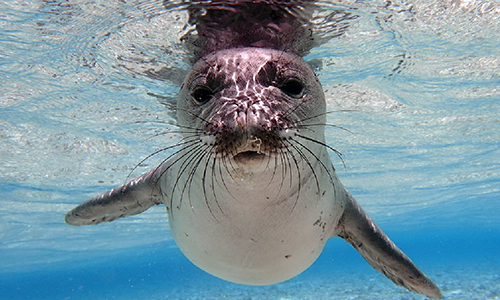
Although you might not be able to see it from your favorite spot on the beach where you like to lay out and tan, pollution is everywhere in the ocean. From oils to chemicals, marine life is suffering. Plastic may be the biggest pollutant. It’s in almost every part of the human life. It’s cheap to make and profit off of, but it hasn’t been disposed of properly, leading to the suffering of marine animals. Read up on some of the most endangered species that would be much better off if people just recycled their plastic.
Hawaiian Monk Seal
 Seals
are popular attractions at local zoos because they can learn cute
tricks and look similar to dogs. While seals can be found in a variety
of locations around the world, the Hawaiian Monk seal lives only in the
waters off Hawaii. Since the 1980s, their population has been in a steep
decline. Pollution is one of the biggest reasons for this decline. Over
the span of two months, research teams removed over 12 tons of debris from the Hawaiian Monk seal pupping beaches, most of it plastic.
Seals
are popular attractions at local zoos because they can learn cute
tricks and look similar to dogs. While seals can be found in a variety
of locations around the world, the Hawaiian Monk seal lives only in the
waters off Hawaii. Since the 1980s, their population has been in a steep
decline. Pollution is one of the biggest reasons for this decline. Over
the span of two months, research teams removed over 12 tons of debris from the Hawaiian Monk seal pupping beaches, most of it plastic.
Pacific Loggerhead Sea Turtle
 Sea
turtles are an iconic marine animal, but while figurines can be bought
on necklaces, cups and beach towels, they’re greatly endangered by human
pollution. The Pacific Loggerhead sea turtle is one species that
constantly falls victim to discarded plastics like six pack rings and
plastic packaging. It’s why plastic pollution has been declared more deadly to sea turtles than oil spills.
Sea
turtles are an iconic marine animal, but while figurines can be bought
on necklaces, cups and beach towels, they’re greatly endangered by human
pollution. The Pacific Loggerhead sea turtle is one species that
constantly falls victim to discarded plastics like six pack rings and
plastic packaging. It’s why plastic pollution has been declared more deadly to sea turtles than oil spills.
Sperm Whales
 Whales are mostly passive creatures, eating small organisms like plankton or squid. The sperm whale is one of these, but it’s the most susceptible to plastic pollution.
Their large mouths allow for extreme amounts of plastic to be ingested,
causing cases like an extreme one in 2008. Two sperm whale were found with plastic clogging their digestive tract, leading to both of their deaths.
Whales are mostly passive creatures, eating small organisms like plankton or squid. The sperm whale is one of these, but it’s the most susceptible to plastic pollution.
Their large mouths allow for extreme amounts of plastic to be ingested,
causing cases like an extreme one in 2008. Two sperm whale were found with plastic clogging their digestive tract, leading to both of their deaths.
Cory’s Shearwater
 The
shearwater seabird family is an expansive one, with the Cory being the
largest. It flies over the ocean and dives for its food, which means
that it can easily mistake floating plastic debris for food. In a recent
study of shearwater birds, the Cory has the highest occurrence of ingesting plastics at 70-94 percent.
The
shearwater seabird family is an expansive one, with the Cory being the
largest. It flies over the ocean and dives for its food, which means
that it can easily mistake floating plastic debris for food. In a recent
study of shearwater birds, the Cory has the highest occurrence of ingesting plastics at 70-94 percent.
These are just a few species that would have much longer lives with better quality if recycling became a practiced habit for those who buy or use plastic and if plastics use was more limited. Efforts for getting people better resources like local recycling plants and educating future generations need to be on the front line of concerns for everyone, no matter where they live or what they do.

No comments:
Post a Comment